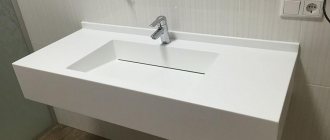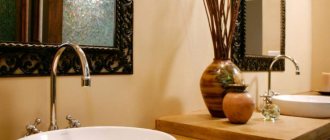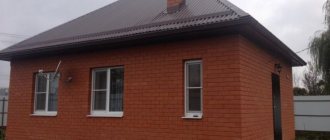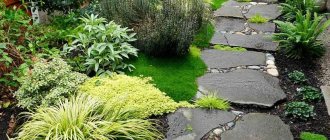yoyoyoyo The website DachaDecor.ru has already posted an article on how to make an artificial stone for your dacha with your own hands. There are quite a lot of interesting details there, except for one - how to make molds for this material. About this right now.
It is impossible to produce high-quality stone without molds into which a solution of a certain composition must be poured. We also mentioned some recipes earlier, as well as the production technology itself, and therefore today we will talk only about molding containers.
What types of blanks exist
The quality of wall cladding with artificial stone depends on compliance with its manufacturing technology. To do this, you need to purchase or make your own special templates that will help you fill a plate of the required geometry and dimensions according to a given pattern.
Molds for making blanks must meet a number of parameters:
- Resistance to mechanical stress. It is necessary that this product be strong and have the ability to stretch without brittleness or tearing. Flexibility is also appreciated, which allows the mold to avoid deformation.
- The ability to endow the surface of produced stone blanks with intended relief lines.
- Resistance to possible negative influences from substances and compounds that will be poured into it.
Currently, different types of molds are used to make stone blanks. They differ in the material that underlies their construction. For example, rigid templates are made from metal or more economical plastic. They can be solid or collapsible.
This is a reliable and durable option, but there are also disadvantages:
- the relief of the resulting stone blocks is not very clear, somewhat blurry;
- It’s inconvenient to fill bulky workpieces;
- possibility of damage to products.
To create semi-rigid models, not the most expensive plastic, polyurethane, is used. Rubber type rubber with hot hardening technology is also suitable.
Such matrices use an additional body, but this will require significantly more material in the manufacture of stone plates.
Elastic samples are popular among builders. They are convenient, easy to use, quite flexible, and effective in making parts for cladding yourself. We will talk about possible solutions below.
What is a mold for decorative stone
A mold for home decorative stone is a flat container with a high ductility index. It has a bottom in the form of the relief that is needed for the manufacture of building material. The product is also divided into several different elements, depending on the required design. Forms can be made from different materials and are selected taking into account what kind of raw materials will be used for filling.
Matrix - what is it?
The matrix is the same mold that is used to produce artificial stone at home. Purchased models are expensive, so you can make the matrix yourself.
- Saving money. Finance will be spent exclusively on raw materials, which cost several times less.
- You can come up with your own original design for the product being manufactured.
- The person will gain useful skills. If you learn how to make simple matrices, then over time the knowledge gained can be applied in some other areas.
- Spin off. If the matrix is made correctly, it will last several times longer than purchased products.
What requirements apply to forms?
The quality of artificial stone will largely depend on what kind of material was used to make the molds. Regardless of this, all forms must meet certain requirements.
- Mechanical strength. A high-quality form should stretch easily and be durable. It should not break or tear if significant force is applied. In addition, the form must necessarily restore all its geometric contours.
- Abrasion resistance. Products of this type must convey everything, even the smallest details of the artificial stone relief.
- High chemical resistance. Most solutions used to produce artificial stone may contain some alkaline elements. They can cause destruction of the mold structure.
How to make at home
It is not necessary to immediately go to a hardware store to buy a template for making stone tiles.
Cheap samples will not be of very high quality, and modern models are too expensive. Therefore, it is recommended to resolve this issue yourself. Here you will learn how to make a mold quickly and reliably.
Assessment of the quality of molds for the manufacture of decorative stone
Don’t worry if the mold for making decorative stone at home doesn’t turn out perfect the first time. A couple of trainings and you will be able to make high-quality goods with minimal costs only on raw materials.
Quality control
Purchased products from reputable manufacturers may be of higher quality than homemade ones. Nowadays there are many fakes on the construction market and no one guarantees that you will be able to purchase a truly worthwhile product the first time.
Preparation of the solution
If you decide to make a polyurethane mold model, you can purchase a two-component solution, such as Duramould ET 45A. Solutions produced by Mold Star, E-Series, NY 600 Series are also suitable.
The package includes two containers with two types of liquid - white and red. It is necessary to take 0.5 liters of each solution and mix it in a bucket with a mixer.
Polyurethane compound
The main consideration when choosing a mold material for casting is the presence of fillers in the compound: to reduce cost, change the strength, weight or appearance of the casting to make the die design more workable before or after solidification. The "A" portion of most two-part polyurethane resins comes with a certain amount of filler already included.
A high quality line of two-component liquid rubbers is available commercially that can be poured, spread or sprayed during the template making process at room temperature.
Polyurethane two-component compound
Polyurethane compound is two solutions based on different polyurethanes. The mixture of combined components solidifies at room temperature.
The material is designed specifically for the manufacture of molds for casting artificial stone, since, thanks to its plasticity, it can easily repeat any complex pattern with maximum accuracy. Due to its liquid state, the raw material can be easily measured, mixed and prepared for casting.
The solution has a fast hardening time, which allows you to work with the matrix a few hours after production, but the time for complete stabilization is about 12 hours.
The presence of filler in the compound will result in exothermic heat buildup, which slows down the curing reaction and reduces the shrinkage rate. When working with cast polyurethane, it is recommended that when using a significant amount of filler, the percentage of added catalyst is increased from the usual 1% to 2% (even up to 4% when mixing small volumes).
Pouring the composition
After preparation, the solution is poured into the matrix. The bubbles that appear on the surface will be forced out and disappear.
It is necessary to fill not level, but above the edges by 10-20 mm. Complete hardening occurs within a day. But for high-quality setting, you need to ensure a temperature of at least 20-22 degrees. However, the form can only be used 3 days after pouring.
For the silicone version, you need to carefully distribute the starting material over the sample using a regular spatula. Dip the brush into the soap solution, and then use it to spread the silicone in layers over the surface. After final polymerization, the matrix is removed and washed from lubricant.
Once the composition has hardened, the formwork can be disassembled. After this, the manufactured mold is removed. If the samples are properly attached to the base, they will remain in place. Otherwise they may end up in the template. In this case, you need to carefully squeeze out the tiles.
If you follow the technology, you can get a product that is close in appearance to the samples shown in the photo of the mold for artificial stone. The emptied mold must be allowed to dry. If necessary, the inner surface can be wiped again to remove moisture and grease.
Thanks to simple steps you will save money and be able to decorate your walls in the most original way. High-quality preparation of the matrix is the key to successfully completed cladding.
Tools and materials for preparation
For high-quality templates that can accurately convey the texture of natural materials, injection molded polyurethane is used. This unique material is resistant to wear, corrosion and flexibility, and can withstand high mechanical loads.
Polyurethane molds are made by cold polymerization, a solution to form two-component polyurethane compounds. Despite the simplicity of the technology, creating a reliable model requires a lot of experience.
To obtain a polyurethane mold with your own hands, you need:
- samples made of artificial or natural stone;
- two-component polyurethane compound;
- sanitary silicone;
- plywood, MDF or chipboard;
- self-tapping screws;
- liter bucket;
- putty knife.
To make frames, you need to prepare a smooth section of MDF or particle board according to the size and pattern of the side wall elements. A texture pattern is copied onto the surface of the plate by mounting plumbing silicone. The distance from the sample to the side walls must be at least one centimeter. Next, the assembled formwork is sealed with a silicone frame and filled with mortar.











